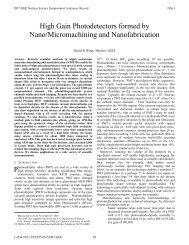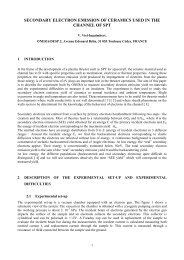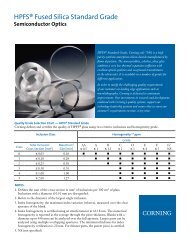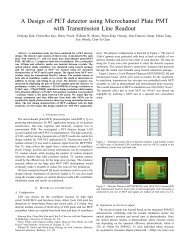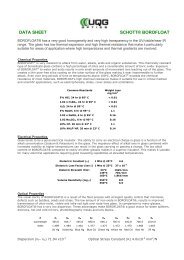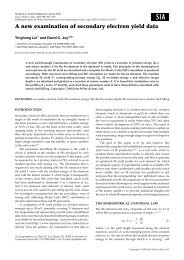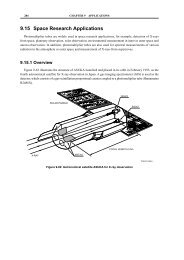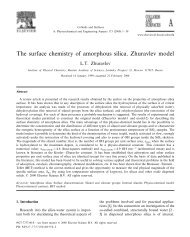the mechanism of channel electron multiplication - IEEE Xplore
the mechanism of channel electron multiplication - IEEE Xplore
the mechanism of channel electron multiplication - IEEE Xplore
Create successful ePaper yourself
Turn your PDF publications into a flip-book with our unique Google optimized e-Paper software.
90 <strong>IEEE</strong> TRANSACTIONS ON NUCLEAR SCIENCE<br />
June<br />
capacity is 2.5 x 109 <strong>electron</strong>s, compared with<br />
<strong>the</strong> experimentally observed saturated gain <strong>of</strong><br />
about 4 x 109.<br />
Saturation in Straight Channels<br />
There are several pieces <strong>of</strong> evidence to<br />
suggest that <strong>the</strong> saturation <strong>mechanism</strong> in curved<br />
<strong>channel</strong>s is different from that in straight<br />
<strong>channel</strong>s.<br />
(i) Figure 14 shows <strong>the</strong> pulses from a<br />
curved <strong>channel</strong>. At low frequencies <strong>the</strong> heights<br />
vary over quite a wide range in a random fashion.<br />
Unlike <strong>the</strong> pulses in Figure 11, <strong>the</strong>ir height is<br />
not related to <strong>the</strong> time interval between <strong>the</strong>m.<br />
(ii) The maximum gain8in curved <strong>channel</strong>s<br />
ap ears to be about 2 x 10 , compared with 4 x<br />
10 in straight ones.<br />
(iii) Placing a capacitative sleeve round a<br />
curved <strong>channel</strong> has no effect on <strong>the</strong> size <strong>of</strong> <strong>the</strong><br />
maximum pulse.<br />
Thus it seems unlikely that field distortion<br />
is limiting <strong>the</strong> gain <strong>of</strong> curved <strong>channel</strong> multipliers.<br />
Bryant and Johnstone4 have considered <strong>the</strong> effect<br />
<strong>of</strong> space charge in <strong>channel</strong> multipliers. Their<br />
analysis is more applicable to straight multipliers<br />
than to curved ones, but <strong>the</strong> same general<br />
principles apply. The cloud <strong>of</strong> <strong>electron</strong>s in <strong>the</strong><br />
<strong>channel</strong> increases in density until it is sufficient<br />
to drive secondary <strong>electron</strong>s back into <strong>the</strong><br />
<strong>channel</strong> wall without <strong>the</strong>ir acquiring enough<br />
energy from <strong>the</strong> field to produce more secondaries.<br />
A state <strong>of</strong> dynamic equilibrium is reached when<br />
this happens. It follows from Gauss' Law that n,<br />
<strong>the</strong> number <strong>of</strong> <strong>electron</strong>s per cm length uniformly<br />
distributed within a cylinder which will produce<br />
a voltage depression V volts at <strong>the</strong> centre <strong>of</strong> <strong>the</strong><br />
cylinder is given by n = 7 x 106 V <strong>electron</strong>s/cm.<br />
Few <strong>electron</strong>s emerge from <strong>the</strong> <strong>channel</strong> with<br />
energies exceeding 100 eV. We may presume <strong>the</strong>refore<br />
that <strong>the</strong> maximum collision energy in <strong>the</strong><br />
<strong>channel</strong> is also 100 eV. Channels are invariably<br />
vitreous and since for most glasses <strong>the</strong> secondary<br />
emission coefficient is unity at about 50 eV, a<br />
reduction in collision energy by a factor 2 would<br />
inhibit <strong>the</strong> gain process. It can be shown that a<br />
voltage depression <strong>of</strong> about 2.8 times <strong>the</strong> emission<br />
energy is required to achieve this reduction.<br />
This would suggest a maximum charge density <strong>of</strong><br />
about 2 x 107 <strong>electron</strong>s/cm for 1 volt <strong>electron</strong>s.<br />
The output pulse persists for about 4 x 10-8<br />
seconds, and since <strong>the</strong> mean energy is about 50 eV,<br />
<strong>the</strong> space charge limited gain is about 3 x 108<br />
<strong>electron</strong>s. It should be noted that this is not a<br />
function <strong>of</strong> tube diameter. This result accords<br />
well with experimental findings.<br />
We can summarise by saying that in curved<br />
<strong>channel</strong>s <strong>the</strong> short pulse is limited by space<br />
charge, while in straight <strong>channel</strong>s <strong>the</strong> long pulse<br />
train is limited by changes <strong>of</strong> <strong>the</strong> potential <strong>of</strong><br />
<strong>the</strong> <strong>channel</strong> wall.<br />
PULSE HEIGHT DISTRIBUTION<br />
We have already alluded to <strong>the</strong> pulse height<br />
distributions in straight and curved <strong>channel</strong>s.<br />
We can now consolidate <strong>the</strong> discussion <strong>of</strong> <strong>the</strong>se<br />
phenomena.<br />
In straight <strong>channel</strong>s <strong>the</strong> pulse height<br />
distribution at maximum gain is very narrow at<br />
low pulse repetition rates. Figure 15 shows <strong>the</strong><br />
contrast between <strong>the</strong> spread in height <strong>of</strong> <strong>the</strong><br />
starter pulses which did not initiate feedback<br />
and <strong>of</strong> <strong>the</strong> larger saturating pulses. It shows<br />
that as <strong>the</strong> multiplying voltage and <strong>the</strong>refore<br />
<strong>the</strong> gain is increased <strong>the</strong> proportion <strong>of</strong> starter<br />
pulses giving rise to feedback also increases.<br />
As <strong>the</strong> pulse repetition rate rises, <strong>the</strong><br />
interval between pulses becomes shorter than <strong>the</strong><br />
recovery time <strong>of</strong> <strong>the</strong> multiplier. The height <strong>of</strong><br />
a pulse <strong>the</strong>refore becomes a function <strong>of</strong> <strong>the</strong> time<br />
interval since <strong>the</strong> preceding one, and <strong>the</strong> pulse<br />
height distribution broadens.<br />
In a curved <strong>channel</strong> <strong>the</strong> maximum pulse<br />
height is limited by space charge and this shows<br />
itself in <strong>the</strong> pulse height distribution. Figure<br />
16 shows distributions obtained from a Mullard<br />
B300A multiplier at various applied voltages.<br />
The resolution <strong>of</strong> a distribution is defined as<br />
<strong>the</strong> ratio <strong>of</strong> <strong>the</strong> full width <strong>of</strong> <strong>the</strong> distribution<br />
at half peak height to <strong>the</strong> gain at <strong>the</strong> peak<br />
height. The resolution improves with gain in<br />
<strong>the</strong> range 105 to 107 but <strong>the</strong>n worsens at about<br />
108. The best resolution is about 0.45, which<br />
is to be compared with about 1.5 obtained in<br />
conventional multidynode multipliers. The<br />
resolution in a conventional multiplier is<br />
limited by <strong>the</strong> statistical variation <strong>of</strong> <strong>the</strong><br />
gain at each stage. According to Lombard and<br />
Martin5, a resolution <strong>of</strong> 1.5 implies a gain per<br />
stage <strong>of</strong> 5, whereas a resolution <strong>of</strong> 0.45 would<br />
require a gain per stage <strong>of</strong> 25. Fur<strong>the</strong>rmore <strong>the</strong><br />
variation <strong>of</strong> gain at each collision in a <strong>channel</strong><br />
will be greater than that in a conventional<br />
multiplier, so an even higher mean gain would be<br />
required to account for <strong>the</strong> resolution <strong>of</strong> <strong>the</strong><br />
<strong>channel</strong>. Because such high gains per stage do<br />
not occur in <strong>channel</strong>s it is evident that <strong>the</strong><br />
narrow distribution cannot be accounted for<br />
statistically, but results from <strong>the</strong> progressive<br />
constraint which space charge imgoses<br />
process when <strong>the</strong> gain exceeds 10 .<br />
on <strong>the</strong> gain<br />
The resolution worsens at gains above 10<br />
and as Figure 16 shows, <strong>the</strong> distribution has a<br />
double peak at 5 KV. This effect is due to<br />
secondary pulses which appear at <strong>the</strong> tail <strong>of</strong> <strong>the</strong><br />
normal curved <strong>channel</strong> output pulse. The probability<br />
<strong>of</strong> occurrence <strong>of</strong> secondary pulses increases<br />
with gain and with <strong>the</strong> length <strong>of</strong> <strong>the</strong> straight<br />
part <strong>of</strong> <strong>the</strong> <strong>channel</strong>.<br />
The cause <strong>of</strong> secondary pulsing <strong>the</strong>refore<br />
seems to be ionic feedback. It is not clear why<br />
<strong>the</strong> number <strong>of</strong> secondary pulses is limited. If<br />
<strong>the</strong> probability <strong>of</strong> feedback is as high as <strong>the</strong><br />
pulse height distribution indicates <strong>the</strong>n <strong>the</strong>re



